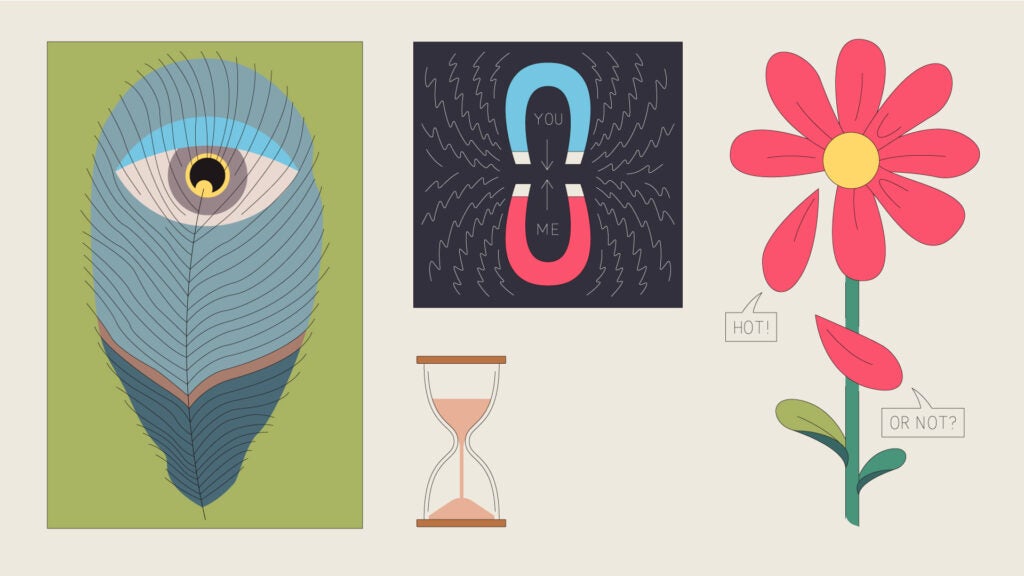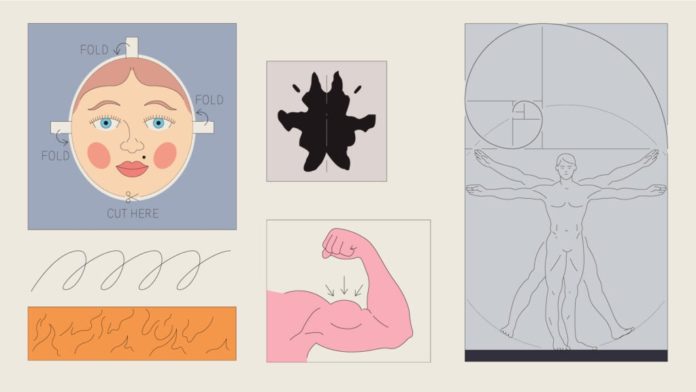In the animal kingdom, tempting a mate appears easy. Male peacocks unfurl their sexy feathers when they spot a would-be love. Spiders woo with the erotic gift of dead insects. For humans, the prospect of such a simple path to achieving hotness can be mighty tantalizing. But can science identify a shortcut to that initial spark and a key to fanning the flames of a successful relationship?
Probably not. But that hasn’t kept everyone from the ancient Greeks to modern psychologists and anthropologists from searching. While neuroscientists have identified a behavioral “attraction system” that seems to activate nerve cells in the midbrain to release the oh-so-pleasurable neurotransmitter dopamine when we’re into someone, they still don’t understand why only some potential mates spur activity. Over thousands of years, people have landed on only vague clues in pursuit of the keys to this ineffable magnetism.
Take 1.618…, the golden ratio. This supposedly pleasing number has been on our minds since at least 300 BCE. Mathematician Euclid offered that if you take a segment of a line and divvy it up into roughly 60/40 parts, the ratio of the larger chunk to the entire line equals the ratio of the segments to one another. When applied to physical proportions, the schema is thought to produce beautiful results.

The golden ratio gained popularity during the Renaissance, where artists and thinkers, most notably Leonardo da Vinci, held it up as the epitome of visual harmony (read: facial hotness). Modern proponents claim our eyes are immediately drawn to faces that are about 1.6 times longer than they are wide and that have bottom lips 1.6 times as full as their uppers. But after reviewing dozens of papers on the subject, the researchers behind a 1995 study in the journal Perception failed to come to any definitive conclusion about whether people associate the ratio with attractiveness—let alone whether it can help them snag dates.
[Related: We might have started kissing to share chewed up food (and other delicious facts about smooching)]
As with so much psychology, research on the subject is littered with small sample sizes and baked-in biases. Over the decades, study authors have identified a general lean toward facial symmetry, but that doesn’t mean it’s the sole measure of sex appeal. A 2015 literature review in the Dental Press Journal of Orthodontics noted that up to one in three people has some amount of facial asymmetry, and it’s not as if that many of us belong to the lonely-hearts club. Beyond that, what we see as hot can be a moving target. A 1980 study in Psychological Reports showed that Miss America contestants and Playboy models had gotten thinner over the two preceding decades; a similar study in 2002 showed there’s never been any consistent hip-to-waist ratio among winners and centerfolds, negating the myth of a universally appealing hourglass. A 2008 report in Personality and Individual Differences ID’d men with light stubble as more attractive than bros with beards or clean shaves, but we know trends have swung from heavy hair to clean faces and back in the last century.

Though individual preferences vary, whatever we think “attractiveness” means, we sure care a lot about it. One 2005 study out of the University of Pennsylvania assessed data from more than 10,000 individuals who signed up for speed dating, mass events in which participants have a series of brief meetings with multiple potential partners. Would-be matches decided to pursue second dates based almost exclusively on “physically observable attributes” (think height, weight, age). Personality and things commonly cited as deal breakers, like differences in religious belief or education levels, weren’t as significant as factors folks could spot right away.
“The first time you meet someone, physical attractiveness matters a lot,” says Paul Eastwick, a psychology professor at the University of California, Davis who studies how people initiate romantic relationships.
[Related: How a Victorian heart medicine became a gay sex drug]
How well you play the dating game also has an effect. A 2020 study in the Journal of Social and Personal Relationships suggests that people can manipulate their “mate value”—their ability to be more selective and their perceived reproductive viability—by playing hard to get. In a series of online and in-person experiments, the researchers found that those who seemed more choosy about their mates generated more sexual attraction than those who didn’t appear to be picky about who slid into their DMs.
But spotting a hottie (and getting them to spot you) in the wild is only half the equation. What are the odds you’ll actually like one another? The science there is even more iffy. “If compatibility is so great, then where does it come from?” Eastwick asks. “For me, that’s the great question we have to tackle.”

In the absence of the ability to send people out on a big number of perfectly controlled rendezvous, speed dating is the next best thing. It gives scientists like Eastwick the opportunity to set up a large group of singles and see if his team can predict how much a person tends to like other humans in general, whether that person tends to be liked by others, and how well two unique individuals will click as a relationship unit.
In 2017, Eastwick and colleagues had participants complete a questionnaire that measured more than 100 traits and preferences—with queries designed to suss out things like attachment styles, relationship goals, basic personality attributes, and someone’s own rating of their physical features—before going on quick dates. An algorithm used the proffered info to forecast who would sizzle and who would fizzle. Though the predictions could reliably foretell which subjects would like partners in general or be generally liked, the computer turned out to be terrible at determining whether two individuals would like each other specifically. “Can we say why two people hit it off and other people didn’t? That’s the kind of prediction we can’t really do yet,” says Eastwick.
When it comes to actual hookups, each pairing seems to be almost entirely dependent on the twists and turns not just of physical connection, but also of conversational dynamics, mood, and other seemingly random factors. “We have to find ways of studying each relationship as its own little precious entity,” says Eastwick. He and his colleagues are trying to come up with ways to do just that. In the meantime? “I’m just excited that we can now properly articulate the problem,” he says.








